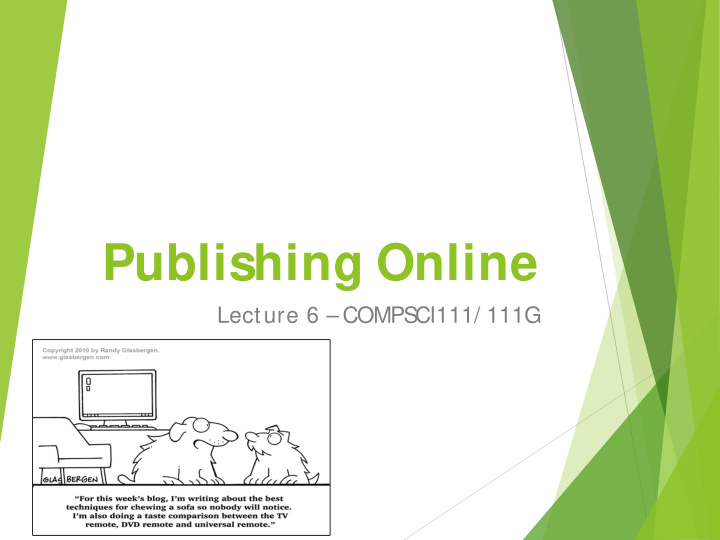



Publishing Online Lecture 6 – COMPS CI111/ 111G
Today’s lecture Blogs Wikis
Blogs S hort for web log , a website where posts are displayed in reverse chronological order (ie. newest posts first) Around 150 million blogs worldwide on a range of topics from personal to political Range of uses for a blog: Personal Provide commentary on an issue Keep followers up to date
Blogs Different kinds of blogs: photo blog, video blog (vlog), audio blogs (podcasts) Online blogging platforms include Blogger, Wordpress, S ilvrback Y ou can even host your own blog using Ghost, Wordpress, Joomla
Microblogging A form of broadcast communication that is similar to blogging The key difference is that smaller portions of content are shared on microblogs Well-known microblogging platforms include: Twitter Tumblr Pinterest Instagram
Wikis A set of public webpages that can be edited by anyone, which encourages collaboration Can also have private wikis that can only be edited by authorised people Created by Ward Cunningham in 1995. Named after the ‘ wiki-wiki’ shuttle buses in Hawaii (‘ wiki’ means ‘ quick’ in Hawaiian) Wiki pages are written in plain text, with wiki markup used to add formatting (italicise text, add links etc.)
Wikipedia Wikipedia is the best known wiki. Launched in 2001 by Jimmy Wales and Larry S anger Today, it has over 5.3 million English articles with around 20,000 articles added each month Funded by grants and public donations Wikipedia runs on the MediaWiki software platform and is hosted on around 400 servers
Wikipedia Advantages: Everyone can access and contribute to Wikipedia Easy to use Quick to develop material Enormous amount of topics and information available Disadvantages: No direct quality control Bias in some articles Information changes rapidly Vandalism is a real problem
Wikipedia - vandalism Wikipedia has a number of automated and manual systems for addressing vandalism Bots: vandalism is automatically detected and reverted by a bot called ClueBot NG Recent change patrol: a group of people monitor the Recent Changes page to modify or remove vandalism Can also modify or remove edits that don’ t meet Wikipedia’s standards
Wikipedia - vandalism Watchlists: registered users can watch a page that they have created/ edited or are interested in, allowing them to watch for vandalism Reader-reported vandalism: readers can address vandalism by: Reverting to an older version of the page Warning the vandal that their actions have been noted Report the vandal to Wikipedia administration
Wikipedia’s reliability 2005 study in Nature: experts analysed 42 articles, found the articles had the same error rate as Encyclopedia Britannica A summary of other studies can be found on Wikipedia Generally, Wikipedia articles on academic topics are more accurate than articles on pop culture and politics Maybe because these articles are more subj ective or opinion-based? Wikipedia should be a starting point for research rather than a definitive source of information
Computer Science wiki The CS Department hosts a number of Wikis, which use the MediaWiki software Anyone can read the wiki but only CS students can edit the wiki when the log in Y ou’ ll get to contribute to the S tage One Wiki in the labs
Wiki markup A special language used to format wiki pages S ome wikis accept wiki markup and HTML tags (which we’ ll see later in the course) Chapter 4 of the online reference manual contains a helpful guide to wiki markup
Wiki markup - paragraphs A new line is ignored while a blank line creates a new paragraph
Wiki markup - headings Four levels of headings: =Main heading= ==Section heading== ===Subsection heading=== ====Sub-subsection heading====
Wiki markup - formatting Emphasis ''Emphasised Text'' S trong '''Strong text''' Very S trong '''''Emphasised and strong'''''
Wiki markup - links Two kinds of links: Internal links: used to link to other pages in the wiki External links: used to link to other webpages Internal link: [[name of page]] [[User:Dazh001]] External link: URL http://www.auckland.ac.nz
Wiki markup - links Y ou can add labels to links so they they’ re easier for readers to understand Internal links: [[name of page | label]] [[User:Dazh001 | Damir]]
Wiki markup - links External links [URL label] [http://www.auckland.ac.nz UoA] Note only one pair of square brackets and a space instead of a bar character
Wiki markup - lists Two kinds of lists Unordered lists: Uses the * character in front of each list item Use multiple * to create sub-lists
Wiki markup - lists Ordered lists: Uses the # character in front of each list item Use multiple # to create sub-lists
Questions What kinds of Wikipedia articles are more likely to be accurate? What is the key difference between blogs and micro-blogs? What would the following wiki markup look like when viewed in a web browser?
Answers What kinds of Wikipedia articles are more likely to be accurate? Academic topics What is the key difference between blogs and micro-blogs? Micro-blogs are designed for sharing smaller pieces of content
Answers What would the following wiki markup look like when viewed in a web browser?
Recommend
More recommend